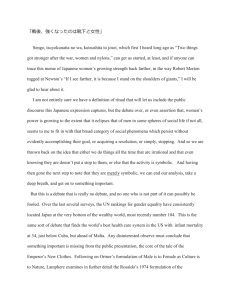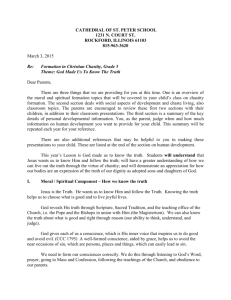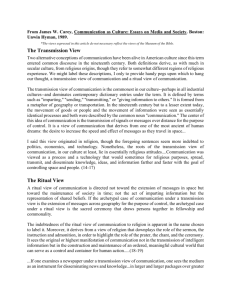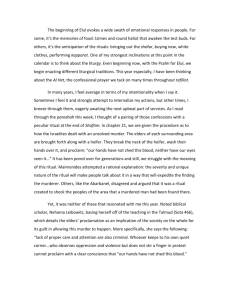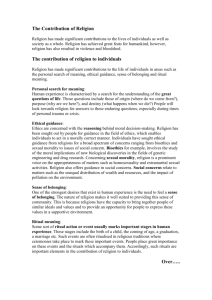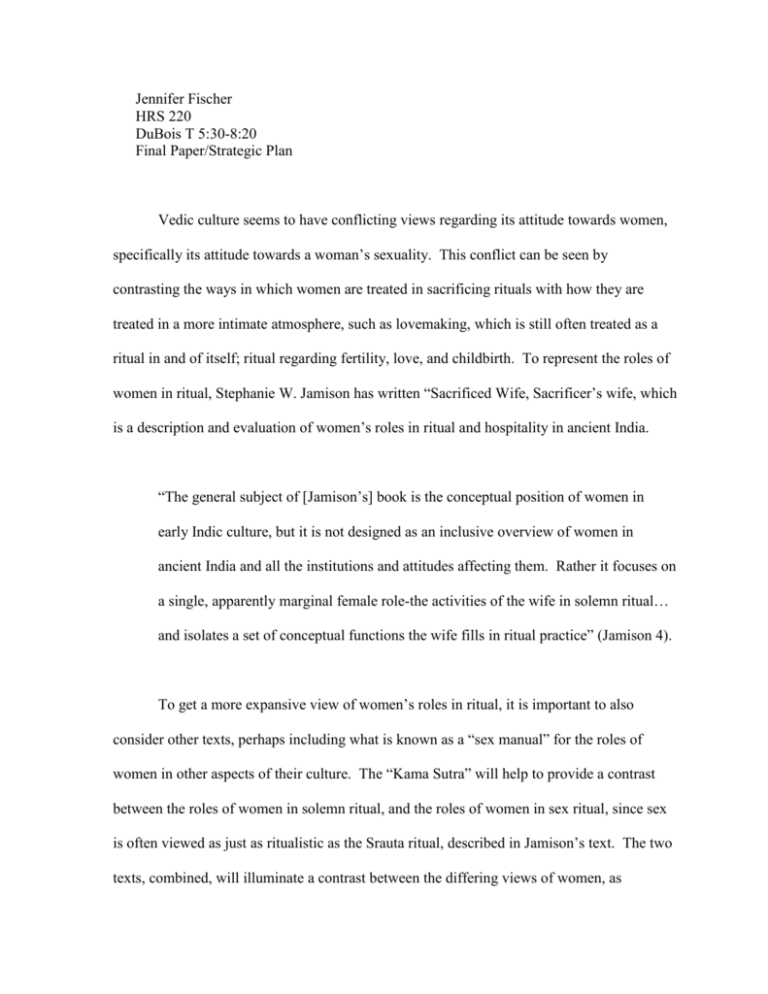
Jennifer Fischer
HRS 220
DuBois T 5:30-8:20
Final Paper/Strategic Plan
Vedic culture seems to have conflicting views regarding its attitude towards women,
specifically its attitude towards a woman’s sexuality. This conflict can be seen by
contrasting the ways in which women are treated in sacrificing rituals with how they are
treated in a more intimate atmosphere, such as lovemaking, which is still often treated as a
ritual in and of itself; ritual regarding fertility, love, and childbirth. To represent the roles of
women in ritual, Stephanie W. Jamison has written “Sacrificed Wife, Sacrificer’s wife, which
is a description and evaluation of women’s roles in ritual and hospitality in ancient India.
“The general subject of [Jamison’s] book is the conceptual position of women in
early Indic culture, but it is not designed as an inclusive overview of women in
ancient India and all the institutions and attitudes affecting them. Rather it focuses on
a single, apparently marginal female role-the activities of the wife in solemn ritual…
and isolates a set of conceptual functions the wife fills in ritual practice” (Jamison 4).
To get a more expansive view of women’s roles in ritual, it is important to also
consider other texts, perhaps including what is known as a “sex manual” for the roles of
women in other aspects of their culture. The “Kama Sutra” will help to provide a contrast
between the roles of women in solemn ritual, and the roles of women in sex ritual, since sex
is often viewed as just as ritualistic as the Srauta ritual, described in Jamison’s text. The two
texts, combined, will illuminate a contrast between the differing views of women, as
Jamison’s book illuminates negative attitudes towards a woman’s sexuality and inequalities
in the participation in ritual, whereas the “Kama Sutra” will show a more egalitarian view of
women’s sexuality giving it room to be praised and explored and allowing equal participation
across gender lines in order for maximum sexual pleasure.
The purpose of this paper is to examine the sexual roles of women in Vedic culture,
paying particularly close attention to the vast contrast and similarities between the treatment
of women in ritual versus the treatment of women within the male-female relationship,
keeping in mind the concept of ‘yoni’, crucial to the Vedic Scriptures, specifically the
principal Upanishads. To make this comparison, I intend to compare the discussion of these
roles in “Sacrificed Wife, Sacrificer’s Wife” with the portrayal of women in “The Kama
Sutra”. These texts are particularly interesting due to their referral to the same culture with
completely different lenses that illuminate certain contradictions, yet they contain many
similarities. In “Sacrificed Wife, Sacrificer’s Wife” the woman is looked at as a tool for
ritual and a server of hospitality, even though she is still viewed as the bringer of sexuality.
In the “Kama Sutra” this sexual aspect is further explored, in a way that is perhaps more
exonerating, yet the woman’s duties to the husband are still acknowledged.
A quotation from “Sacrificed Wife, Sacrificer’s Wife” encompasses the main idea
behind both texts. “Women are perceived as the primary locus of active sexuality in ancient
India”. Perhaps this is because women are described as containing more parts of sexuality
than men, men only contain one. “Sacrificed Wife, Sacrificer’s Wife” uses this quote to
explain why women “act as the conduit to introduce sexual energy into the potentially sterile
world of the orderly ritual. Their very presence traps sexuality and its power for ritual use”
(Jamison 53). For example, in the Srauta ritual, the woman must first be made fit to partake
in the ritual. The ritual begins with the threshing and grinding of the grain. Yet more must
be done in preparation, such as making the wife fit for ritual. Before the wife is fit for the
ritual, she must be ‘yoked and unyoked’. The wife is girded and will sit with her knees
raised or stands in her place near the ‘Garhapyata’ fire. A priest will then tie a cord of munja
grass around her waist, beneath her upper garment, but on the outside of her lower one.
Mantras are recited during this action (Jamison 43). When the wife is fit for ritual, she is
then allowed to participate. Perhaps the wife’s most important actions in the ritual are
‘taking hold from behind’ and looking at the butter. ‘Taking hold from behind involves
“touching someone or something from behind, either with a hand or with some intermediary
material like a blade of grass, while the other person is performing some action like pouring
an oblation” (Jamison 53). While the Sacrificer is touching the sacrificial victim from
behind, the wife is touching him from behind. “The Pratiprasthatar touches him [the victim]
from behind with the two omentum skewers; the Adhavaryu (touches from behind) the
Pratiprasthatar; the sacrificer the Adhvaryu” (Jamison 54). The wife also looks at the butter
that will be used in the ritual, which is a metaphorical way of taking hold from behind.
Eventually the wife will be unyoked and then given a broom, which will also be unyoked.
She will take the strands from the broom and place them between her legs while reciting
mantras.
Another Vedic ritual that the woman’s sexuality is a key player in is the
‘Varunapraghasa’ ritual. In this ritual, the wife is asked how many lovers she has. She is not
given the opportunity to say “none”, because the answer of “none” would not serve the
purpose of this ritual. The woman must confess to the sin of adultery in order to cleanse all
of the others involved in this ritual. Then, the wife and husband offer meal dishes with a
mantra. Then the priest will offer as a Ram and Ewe fashioned out of grasses or something
similar, which was made prior to the wife’s confession. The Ram and Ewe have enlarged
sexual organs to promote fertility.
The woman’s tasks are hers as she is the symbol of sexuality in the ritual. All of her
roles are necessary because they all bring an essential sexuality to the rituals. “Women are
perceived as the primary locus of active sexuality in ancient India. Therefore they act as the
conduit to introduce sexual energy into the potentially sterile world of the orderly ritual.
Their very presence traps sexuality and its power for ritual use.” (Jamison 53). Reviewing
each of the wife’s tasks in the two rituals outlined above, it is apparent that each of her
actions is either to bind her own sexual powers or to add sexuality to the ritual. At the start
of the Srauta ritual, the wife must be made fit by binding her sexual body parts. Then, she
must look at the butter. The wife’s looking at the butter is intended to add sexuality to the
butter, to create a sexual pairing. This symbolizes the butter as semen. “Her glance conveys
sexuality into the butter… (she) makes a sexual pair with it” (Jamison 56). “The wife is
really a woman, the butter semen. A generative sexual pairing is thus made” (Jamison 56).
Later, in the same ritual, the wife puts the blades of grass between her thighs. “Now as to
why the wife unties (the broom). The wife is a woman/female, the broom is a
man/masculine. In this way a procreative sexual pairing is made.
Perhaps the sexual nature of the second ritual is even more apparent. In this ritual,
the woman is asked to confess to the entire group whom she has had sexual relations with.
She is not given an opportunity to say none, as this would not allow the ritual to continue.
Thus, the woman must point out whomever she has slept with. It seems, at first glance that
this is perhaps a humiliating ritual, but it is in fact, not quite as such. It would also seem that
the ritual would be interrupted by enraged husbands, but it is also not as such. This part of
the ritual is necessary in order to raise the level of sexual energy. Such cannot be done with
the discussion of marital sex, but must be done with the admission of a more taboo form of
sex. In the wife’s admission of adultery, everyone at the ritual is then relieved of their sins.
In a sense, the wife becomes a scapegoat, taking on the responsibility of relieving everyone
involved of their sins. She is the scapegoat, because she is a symbol of untruth in this
culture.
“The ritual is truth and reality. Woman is untruth. Indeed a wife who, though bought
by her husband, then goes about with others and does untruth. Discharging her
untruth, she approaches truth and reality…So when he makes her talk [confess], he
thus makes her ritually fit” (Jamison 91).
In taking the responsibility for her own actions, even if she is only pretending that they were
her actions, she is allowing her husband to be forgiven of any of his transgressions. It seems
that in a patriarchal society, it is the husband that is much more likely than the wife to have
committed any form of adultery. Her role in both of these rituals is to bring her sexuality to
it, which in itself does not show a negative connotation, however, it is the ‘making fit’ of the
woman in the Srauta ritual, and the scapegoating of the woman in the Varunapraghasa ritual
that provides the evidence of the negativity involved with the male view of woman’s
sexuality. It is almost as if she is to blame for her own sexulity, and at the same time is some
sort of deviant, that stands to profit if her sexuality is allowed to run free.
The “Kama Sutra shows the opposite opinion of women’s sexuality. In the “Kama
Sutra” a woman’s sexuality is allowed to have more freedom, in fact, she is allowed to have
control over some situations, either implicitly, such as in her courtship and in her first sexual
experience with her husband, or explicitly such as in courtesanship. In a certain section in
the book, where the text is discussing “instilling confidence in the bride”, the man must win
over his bride, he must make her want to be with him, not the other way around. He must
make her trust him and feel comfortable with him. “On the tenth night [after the wedding],
the man should commence gentle love-play with soft words, thus winning the girl’s
confidence… Being of a tender nature, women desire gentle beginnings, and if forcibly
approached by men with whom they are only slightly acquainted, they can become fearful of
a sexual relationship, and may even become male haters. The man should therefore approach
the girl according to her liking, and employ those devices by which he may be able to inspire
her confidence” (Dane 139). As you can see, the above quote describes that the man should
not command control of the situation, but instead should do what the wife likes. This shows
her power, unlike in “Sacrificed Wife, Sacrificer’s Wife”, where the woman is merely a
pawn in the situation, used for her sexuality instead of being treated kindly because of it.
There is also a sense in which a courtesan is in control of her sexuality. In one sense,
she maintains control out of her ability to convince her lovers that she loves them. In another
sense, she is in control of her sexuality the way a small business owner is in control of their
business. A courtesan receives payment for her sexuality, and has control over such
transactions.
“The artifices to be used for obtaining money from her lover are: taking money from
him for the purchase of ornaments, food, drink, flowers, perfumes and clothes, and
either not buy them or buy them at a lower cost; praising his intelligence to his face,
thereby obliging him to present gifts on festive occasions connected with vows, tree
worship, garden parties, temple feasts and Holi- the festival of color” (Dean 265).
“The duty of a courtesan consists in forming connections with suitable men after due
and full consideration, and attaching the person with whom she is united to herself;
in obtaining wealth from the person attached to her, and then dismissing him after she
has taken away all his possessions” (Dean 267).
In this particular relationship, between man and courtesan, the courtesan is in control, she
gets what she wants from the man and then discards him whenever she so chooses. But more
important than the possibility of female sexual control are the ideals of equality. The “Kama
Sutra”, focuses on what a woman brings to her relationship with her husband, rather than
what she brings to the ritual, or her relationships with the devas. The “Kama Sutra” even
allows for a sort of equality between the man and woman, whereas, in the ritual, the male
seems to have complete control. “There are, then, nine kinds of union according to
dimension. Equal unions are the best; the highest and the lowest are the worst” (Dane 58).
The reference is into the dimensions of body parts, yet the same equality is important for the
unions of passion and time. This means that a sexual union is best when the two partners are
equal lovers. Quite an appalling concept when one takes into mind that the culture being
referred to is patriarchal. It might be thought that it does not matter what the man brings to
the bedroom, because the woman’s pleasure could be unimportant, but the “Kama Sutra”
does not claim as such. According to these principles of classification, man can be in one of
three different classes, shasha, the hare; vrisha, the bull; and ashwa, the horse, depending on
the size of his phallus. The woman is also classified, based on the depth of her yoni (vagina),
mrigi, female deer; vadava, a mare; or a hastini, female elephant (Dane 57). Depending on
the classification of each partner, the union may be equal or unequal. The ‘hare’ ought to be
partnered with a ‘deer’, the ‘bull’ ought to be partnered with the ‘mare’, and the ‘horse’
ought to be partnered with the ‘elephant’. There are also variances in passion; small,
middling, and intense, and variances in time, regarding stamina (Dane 58). The
classifications are made in order to qualify the equality of a couple. For the best pairing, the
couple ought to be equal to each other in as many of these ways as possible. The same
principles regarding equality are not found in Vedic ritual, where the woman is not equal to
the men in the ritual.
The differences between “Sacrificed Wife, Sacrificer’s Wife” and the “Kama Sutra”
include not only differences in the prescriptions of equal actions, but also differences in the
way in which women are perceived. In “Sacrificed Wife, Sacrificer’s Wife” women are
talked about in a more degrading way, such as in the following quote that is very derogatory.
“The ritual is truth and reality. Woman is untruth. Indeed a wife who, though brought by her
husband, then goes about with others and does untruth. Discharging her untruth, she
approaches truth and reality… So when he makes her talk [confess], he thus makes her
ritually fit” (Jamison 91). The quote is referring to a ritual in which the woman is forced to
confess to an act that she probably didn’t even do, but she must confess because she is the
ritual’s symbol of untruth, and her confession cleanses all of the participants in the group.
Using the woman as a symbol for untruth puts a negative connotation on her sexuality,
whereas the “Kama Sutra” speaks of the woman’s sexuality in a more positive manner.
The difference between the two texts that is perhaps the most stark is in reference to
what the woman wants. In “Sacrificed Wife, Sacrificer’s Wife”, women are symbols of
sexuality and givers of hospitality, with very little power to make their own decisions, there
are ruled upon from above or from their husband. This quote in “Sacrificed Wife,
Sacrificer’s Wife”, shows that the woman is not even her own. “Her father guards (her) in
childhood. Her husband guards (her) in youth. Her sons guard (her) in old age. A woman is
not fit for independence” (Jamison 236). It would seem that a woman never gets to make her
own choices, yet in the Kama sutra, the woman can have choices and can have control and
power. It is still discussed, even in the “Kama Sutra” that women have duties as a wife, and
certain ways that they must behave, but men seem to have duties of that same nature. “He
should deduce from her actions what would be pleasing to her” (Dane 109) and act
accordingly. The “Kama Sutra” outlines what a man ought to do to please his wife. It is
about what she will like, not what she must do. It seems that there is much more
considerations for the wife’s feelings and pleasures than in “Sacrificed Wife, Sacrificer’s
Wife”, where she is not allowed any say at all, even when it only concerns herself.
The “Kama Sutra” gives the woman many opportunities to be in control of her own
sexuality, whereas in other aspects of her life, including ritual, she is not even her own, but a
belonging of somebody else’s. But indeed, in the acts of sex, she can gain ownership over
her own body and partake in the acts which she finds acceptable. This begins even in
courtship. “When a girl begins to show her love by outward signs and motions, the lover
should try to win her over entirely by various means” (Dane 150). These various means refer
to the way in which the man ought to woo his woman. There are many examples of this,
physical;
“Whenever he sits with her on the same seat or bed he should say, ‘I have something
tell you in private’, and when she comes to him in a private place, he should express
his love for her more by manner and signs than words” (Dane 151), “When alone
with her in a secluded place, or in darkness, [he] should make love to her”
and non-physical
“and tell her the true state of his mind without distressing her in any way” (Dane
151).
It is apparent in both texts that women in Vedic culture are highly recognized for their
sexuality. They bring the necessary sexuality to solemn ritual, and they bring sexual
gratification to men. However, in ritual, their sexuality is viewed in a negative way, whereas
in the “Kamas Sutra”, the woman’s sexuality is celebrated, giving her more control over her
own body, and allowing her to receive sexual gratification. There are still passages in the
“Kama Sutra” that discuss the roles of the wife, and the man’s ability to have multiple wives.
I am not trying to suggest that those particular situations could be construed as empowering.
It seems that there is an obvious sense of inequality between men and women in this
particular culture. Rather, I am pointing out that there are conflicting views regarding the
status of women that can be illuminated by examining the role of women in Vedic ritual
versus the role of women in sexual relations. In ritual, their sexuality is used as a tool, and
can be used as such due to the negative views regarding a woman’s sexuality, whereas in the
“Kama Sutra” the woman’s sexuality is appreciated as a beautiful thing, and as a thing that is
capable of being used in a positive way for both the woman and her partner. Certainly there
are even moments of inequality apparent in the “Kama Sutra”, but, there are also passages
that describe the importance of equality, and yet others that describe the duties of a man to
please his wife. Whereas women are treated as deviants for their sexuality in ritual, they are
praised for it in the bedroom, revealing a conflict in male minds as to how they feel about a
woman’s sexuality, confused about whether they want a virgin or a whore.
Works Cited
Dane, Lance. The Complete Illustrated Kama Sutra. Inner Traditions. Singapore. 2003.
Jamison, Stephanie W. Sacrificed Wife, Sacrificer’s Wife. Oxford University Press. New
York. 1996.



